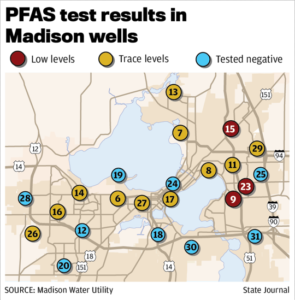Low levels of hazardous PFAS compounds detected in four more Madison wells
Wisconsin State Journal | Oct 17, 2019 | Howard Hardee
 “The Madison Water Utility has found trace or low levels of harmful pollutants known as PFAS in four seasonal wells used during high-demand months in the summer and early fall.
“The Madison Water Utility has found trace or low levels of harmful pollutants known as PFAS in four seasonal wells used during high-demand months in the summer and early fall.
Of the four wells, the highest levels were detected in a rarely used well on Leo Drive, on the city’s East Side, according to data the utility released Thursday. The well, which was last used in the summer of 2017, showed a mix of PFAS compounds at 6.6 parts per trillion — a level described by officials as low.
Trace or low levels of PFAS have been detected in 14 of Madison’s 23 wells this year.
Joe Grande, the utility’s water quality manager, said in a statement that water-monitoring technology has advanced to the point that the utility can detect PFAS in parts per trillion, but the chemicals can be difficult to measure accurately at such low levels.
“The levels are so small,” Grande said. “We can demonstrate that there are detectable amounts, but in many cases we can’t quantify those amounts with a lot of certainty.”
Per- and polyfluoroalkyl substances, or PFAS, are chemicals that have been widely used in manufacturing, firefighting foam, food packaging, non-stick cookware and upholstery for the past several decades.
Public health officials have become concerned in recent years that long-term exposure to PFAS leads to a host of negative health effects on early childhood development and the reproductive system, and increased risk of some forms of cancer.
All 23 wells in Madison fall well below the maximum level of PFAS in groundwater standards recommended earlier this year by the state Department of Health Services. The proposed state standard of 20 parts per trillion for two PFAS compounds — PFOA and PFOS — would be among the most restrictive in the country, but it needs approval from state lawmakers and the governor to take effect.
Grande said the utility will continue to monitor levels of PFAS in Madison’s water.
“I think that there’s a lot of value in the known versus the unknown, and there is an expectation that we know as much as possible about our water and that we communicate that to the public,” he said.
The utility will test the city’s wells for PFAS again next year. ”
Low levels of hazardous PFAS compounds detected in four more Madison wells
More on PFAS and related chemicals…
PFAS – Per and Poly Fluoroalkyl Substance Pollution and the US Military
